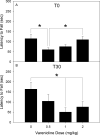The nicotinic acetylcholine receptor partial agonist varenicline increases the ataxic and sedative-hypnotic effects of acute ethanol administration in C57BL/6J mice
- PMID: 20946306
- PMCID: PMC2988947
- DOI: 10.1111/j.1530-0277.2010.01301.x
The nicotinic acetylcholine receptor partial agonist varenicline increases the ataxic and sedative-hypnotic effects of acute ethanol administration in C57BL/6J mice
Abstract
Background: The costs associated with alcohol abuse are staggering, therefore much effort has been put into developing new pharmacologic strategies to decrease alcohol abuse. Recently, the nicotinic acetylcholine receptor (nAChR) partial agonist varenicline has been shown to decrease ethanol consumption in both humans and animal models.
Methods: We examined the effects of varenicline on the ataxic and sedative-hypnotic effects of ethanol. First, varenicline was administered prior to placement in a locomotor activity chamber to determine whether varenicline influenced baseline locomotor activity. To determine the effect of nicotinic modulation on ethanol-induced motor incoordination, varenicline was administered 30 minutes prior to an acute ethanol injection and then mice were tested on the balance beam, dowel test, or fixed-speed rotarod. To examine ethanol's sedative-hypnotic effects, varenicline was administered 30 minutes prior to 4 g/kg ethanol and the duration of loss of righting reflex (LORR) was measured.
Results: Varenicline markedly reduced baseline locomotor activity in C57BL/6J mice. Varenicline increased ethanol-induced ataxia when measured on the balance beam and dowel test but had no effect when measured on the fixed-speed rotarod. Pretreatment with varenicline increased the duration of LORR.
Conclusions: These data provide evidence that nAChRs may be involved in the ataxic and sedative effects of ethanol. It is possible that one mechanism that could contribute to the ability of varenicline to decrease ethanol consumption may be through increasing negative behavioral effects of alcohol.
Copyright © 2010 by the Research Society on Alcoholism.
Figures





Similar articles
-
Nicotine Enhances the Hypnotic and Hypothermic Effects of Alcohol in the Mouse.Alcohol Clin Exp Res. 2016 Jan;40(1):62-72. doi: 10.1111/acer.12918. Alcohol Clin Exp Res. 2016. PMID: 26727524 Free PMC article.
-
Varenicline modulates ethanol and saccharin consumption in adolescent male and female C57BL/6J mice.Brain Res Bull. 2018 Apr;138:20-25. doi: 10.1016/j.brainresbull.2017.07.020. Epub 2017 Aug 1. Brain Res Bull. 2018. PMID: 28778837 Free PMC article.
-
Modulation of ethanol consumption by genetic and pharmacological manipulation of nicotinic acetylcholine receptors in mice.Psychopharmacology (Berl). 2010 Mar;208(4):613-26. doi: 10.1007/s00213-009-1759-1. Psychopharmacology (Berl). 2010. PMID: 20072781 Free PMC article.
-
Neuronal nicotinic receptor agonists improve gait and balance in olivocerebellar ataxia.Neuropharmacology. 2013 Oct;73:75-86. doi: 10.1016/j.neuropharm.2013.05.016. Epub 2013 May 24. Neuropharmacology. 2013. PMID: 23711550 Free PMC article.
-
The nicotinic acetylcholine receptor partial agonist varenicline and the treatment of drug dependence: a review.Eur Neuropsychopharmacol. 2010 Feb;20(2):69-79. doi: 10.1016/j.euroneuro.2009.11.001. Epub 2009 Dec 3. Eur Neuropsychopharmacol. 2010. PMID: 19959340 Review.
Cited by
-
Desformylflustrabromine (dFBr), a positive allosteric modulator of α4β2 nicotinic acetylcholine receptors decreases voluntary ethanol consumption and preference in male and female Sprague-Dawley rats.PLoS One. 2022 Sep 9;17(9):e0273715. doi: 10.1371/journal.pone.0273715. eCollection 2022. PLoS One. 2022. PMID: 36084045 Free PMC article.
-
Relative potency of varenicline or fluvoxamine to reduce responding for ethanol versus food depends on the presence or absence of concurrently earned food.Alcohol Clin Exp Res. 2014 Mar;38(3):860-70. doi: 10.1111/acer.12285. Alcohol Clin Exp Res. 2014. PMID: 25396255 Free PMC article.
-
The effects of varenicline on alcohol seeking and self-administration in baboons.Alcohol Clin Exp Res. 2014 Feb;38(2):376-83. doi: 10.1111/acer.12233. Epub 2013 Aug 19. Alcohol Clin Exp Res. 2014. PMID: 24033702 Free PMC article.
-
UFR2709, an Antagonist of Nicotinic Acetylcholine Receptors, Delays the Acquisition and Reduces Long-Term Ethanol Intake in Alcohol-Preferring UChB Bibulous Rats.Biomedicines. 2022 Jun 22;10(7):1482. doi: 10.3390/biomedicines10071482. Biomedicines. 2022. PMID: 35884787 Free PMC article.
-
The α6 nicotinic acetylcholine receptor subunit influences ethanol-induced sedation.Alcohol. 2012 Aug;46(5):463-71. doi: 10.1016/j.alcohol.2012.03.001. Epub 2012 May 7. Alcohol. 2012. PMID: 22572056 Free PMC article.
References
-
- Baan R, Straif K, Grosse Y, Secretan B, El Ghissassi F, Bouvard V, Altieri A, Cogliano V. Carcinogenicity of alcoholic beverages. Lancet Oncol. 2007;8:292–293. - PubMed
-
- Bergstrom HC, Palmer AA, Wood RD, Burkhart-Kasch S, McKinnon CS, Phillips TJ. Reverse selection for differential response to the locomotor stimulant effects of ethanol provides evidence for pleiotropic genetic influence on locomotor response to other drugs of abuse. Alcohol Clin Exp Res. 2003;27:1535–1547. - PubMed
-
- Boehm SL, 2nd, Peden L, Jennings AW, Kojima N, Harris RA, Blednov YA. Over-expression of the fyn-kinase gene reduces hypnotic sensitivity to ethanol in mice. Neurosci Lett. 2004;372:6–11. - PubMed
-
- Bowers BJ, McClure-Begley TD, Keller JJ, Paylor R, Collins AC, Wehner JM. Deletion of the alpha7 nicotinic receptor subunit gene results in increased sensitivity to several behavioral effects produced by alcohol. Alcohol Clin Exp Res. 2005;29:295–302. - PubMed
Publication types
MeSH terms
Substances
Grants and funding
LinkOut - more resources
Full Text Sources

